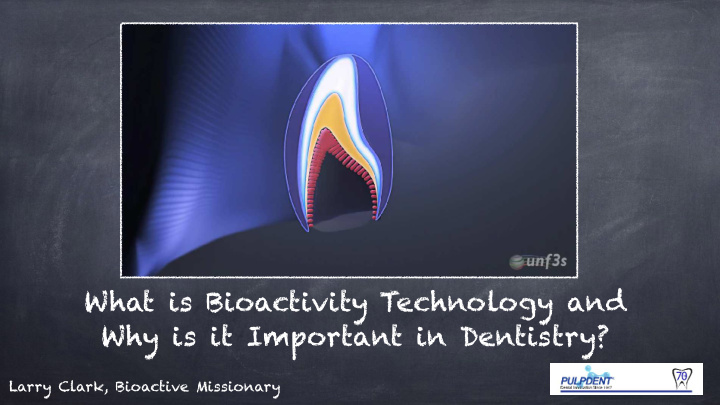



What is Bioactivity Technology and Why is it Important in Dentistry? Larry Clark, Bioactive Missionary
Bioactivity: Moving from Passive to Active What is Bioactivity? What are the current restorative results? What can we expect from Bioactive restorations? What are the patient and economic benefits? Can we participate in this environment and complement nature? The Oral Environment is Dynamic
Repairing Nature 3
The Reality… NIH/NIDCR 2009-2011 The average service length for tooth-colored restorations is only 5.7 years. Replacements of these defective restorations cost about five billion dollars each year in the U.S. alone. If new more durable bonding systems can be developed, they will save patients and governments a great deal of money. 4
90 Million Replacement Restorations/year USA 70% of all restorations in dentistry are replacements for failed restorations (Murray) 2006 data indicates 5 yr replacement 50% higher with composite restorations vs. amalgam (DeRouen) 9-year clinical data shows 50% of class II composite failures are due to gingival margin caries. (Nordbo) 5
We can do better Dentistry TODAY
What Does Oregon State Univ. say about Bioactivity? Watch Video: https:/ /youtu.be/7Qsaoqvprho
The Original Definition of Bioactivity “A bioactive material is one that elicits a specific biological response at the interface of the material, which results in the formation of a bond between the tissues and the material. ” Hench L.L. 1969 Dentin, enamel and the oral environment respond favorably to bioactive materials 8
The Bioactive Continuum “A bioactive material is one that forms a surface layer of an apatite-like material in the presence of an inorganic phosphate solution [Saliva]. ” S.R. Jefferies 2014 In the presence of Saliva, bioactive materials will stimulate formation of Calcium/Phosphate/Fluoride apatite on their surface and at the material-tooth interface. 9
BioACTIVE Ionic Response BioACTIVE Restorative Materials release Calcium and Phosphate minerals to the demineralized tooth, replacing the minerals lost during low pH cycles or from caries. These minerals form a seal and a bond between the material and the tooth structure. 10
The BioACTIVE Mineral Response After demineralization of tooth structure has occurred; the pH rises the minerals equilibrate and stabilize. As apatite forms, it There is an absence of a can occlude the hybrid layer, and there is a tubules helping to chemical desensitize and micro-mechanical bond. 11
Compare to Nature, not other products Tooth Composites RMGIs Attributes Bioac&ve Glass Structure Restora&ve Ionomers s Esthe&c Yes Yes Yes No Yes Moisture-Friendly Yes Yes No Yes Yes Bonding is Op&onal N/A Yes No Yes Yes High Strength Yes Yes Yes No No Releases Calcium, Phosphate & Fluoride Yes Yes No No No S&mulates Apa&te Forma&on Yes Yes No No No Shock-Absorbent /Flexibility Yes Yes No No No Resists chipping and cracking Yes Yes No No No
Bioactivity Seals the Margins Micro-leakage leads to marginal staining, demineralization, and caries Bioactivity and Apatite formation seal the margins and help prevent micro-leakage, caries and failure Images: University of Oregon, Dr. Jack Ferracane, ongoing NIH Grant Bioactive Composite-tooth interface Traditional Composite-Tooth interface Study shows Under identical biofilm conditions, bioactive formation in the composite seals the Bioactive gaps and enamel and dentin Composite demineralization margins, seals out of the enamel biofilm, and protects and dentin against demineralization 13
Is Bioactivity a Chronos or Kairos Moment? Kairos: Qualitative, the Khronos/Chronos: right or the opportune Quantitative, measures moment (the supreme seconds, minutes, hours moment) and days… Data with Thought and Father Time, History and Engagement Speed focus Active Passive Both are favorable, only Kairos is dynamic and a NOW moment!
Dental Opinion Leaders Agree Prof. Salvatore Sauro Dr. Ted Croll “Bioactive materials together with biomimetic remineralization strategies represent an Dr. John Comisi innovative and sound approach to remineralize Dr. Frank Milnar dentine at the resin dentin interface up to its original mechanical properties. These strategies Dr. Robert Lowe have the potential to permanently protect the Dr. Lou Graham hybrid layer, and although more long-term studies are required, they will be a major Dr. Fay Goldstep influence on the future of restorative dentistry. Dr. Delfin Barquero Salvatore Sauro, Professor & Dr. of Biomaterials Dr. Howard Glazer And many more…
More than 3 million BioACTIVE Composite Restorations placed over 4 years 10/2012 1/2017 Dr. John Comisi
Dentists & Patients Agree! “Lack of sensitivity, no chipping, excellent wear and esthetics was reported by patients and dentists at one year recall. ” (Dental Advisor, 2017) “ACTIVA’ s bioactive properties provided a seal at the margin and protected the restoration from microleakge and secondary caries. As a result the life of the tooth is extended and the patient is extremely happy!” (Dr. Bob Lowe)
Thank you! For more information visit www.pulpdent.com
Recommend
More recommend